Patricia Sannit: In Her Own Words
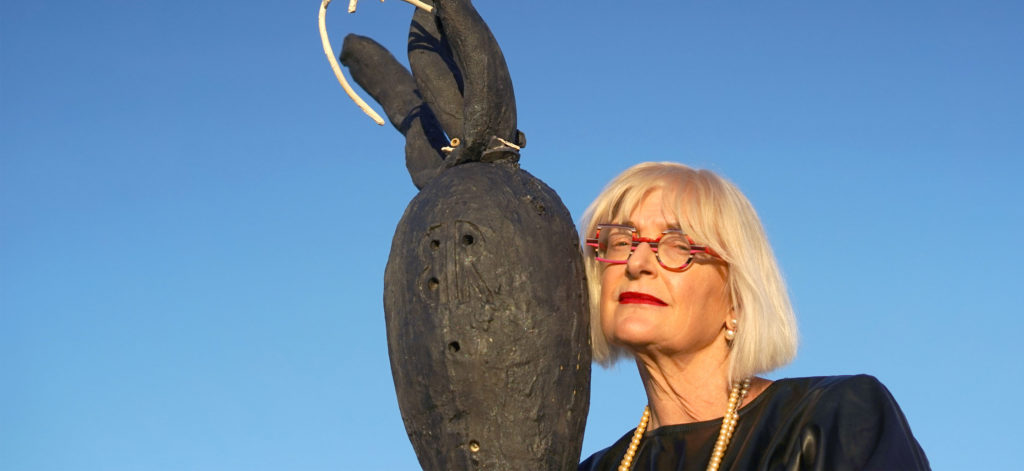
Aug, 23, 2022
ArtistsCommunityPhxArtist Spotlight
Patricia Sannit: In Her Own Words
Growing up, Patricia Sannit was surrounded by art, regularly visiting museums and watching as her family’s own collection of art from around the world expanded. With the encouragement of her parents, Sannit started creating murals and using the pottery studio in their basement, early interests that turned into a lifelong practice and ever-evolving career.
Although clay has been the foundation for Sannit’s work from the beginning, she has cultivated an appreciation for all media, motivated by her insatiable sense of discovery. With a growing interest in ephemeral works, she has expanded her practice to include video, performance, mixed-media works, and landscape intervention, creating interactive and large-scale artworks that have been exhibited across the globe, including Iceland.
Here’s Patricia Sannit, in her own words, on her inspirations, recent projects, and why she’s dedicated to arts education.
“[A]s humans, we have always shared common experiences, impulses, and desires. We build and create, fail and prevail, and attempt to order our natural world. This cycle, and our resilience, offers me hope.”

Patricia Sannit, The Dance (portrait), 2021. Photo: Rembrandt Quiballo.
PhxArt: Tell us about who you are and where you’re from. What was your first inspiration, and what continues to inspire your work?
Patricia Sannit: I was born in Cleveland, Ohio, to parents who loved art and music. We often visited the exceptional and encyclopedic Cleveland Museum of Art. My mom said that I would ask all of the very important and embarrassing life questions, the “where do babies come from?” sort of questions, in a very loud voice, while in the reverberating marble halls of the museum. I fell in love with my first artworks there. Initially it was the fantastic suits of armor in the medieval wing and, most importantly for a nascent contemporary artist, the John Chamberlain sculptures in the modern wing. I always responded more to sculptural forms than paintings.
My parents collected art from local artists and from artists they encountered on their trips around the world. We had beautiful textiles and weavings from Sweden thanks to my mom’s side of the family. One of my aunts lived in Japan, and through her, we also had very special works of Japanese folk pottery and porcelain. This rich visual and cultural environment shaped who I am. I always felt like an artist; my parents encouraged me and gave me free-reign. I painted murals on the walls of our basement, where I also had a pottery studio.
When I was very young, I took a ceramics class at a local art center, Bay Crafters, and fell in love. I was always the messiest kid in the studio and spent as much time there as I could. It was a second home for me, and I am grateful to my teacher, Jill Funk, for introducing me to the expressive qualities of clay.
There has never been a time in my life when I wasn’t making art. Investigation, curiosity, and a sense of unfolding discovery continually motivate and drive me. I’m open to working with all media and am excited by solving structural problems, experimenting, and seeing what happens. I think of myself as someone addicted to complexity and holding oppositional points of view simultaneously. Additionally, I think that the nuanced and slippery language of visual art allows the ability to address complex problems, address shifting perspectives, and speak symbolically. I strive to be original in my work.
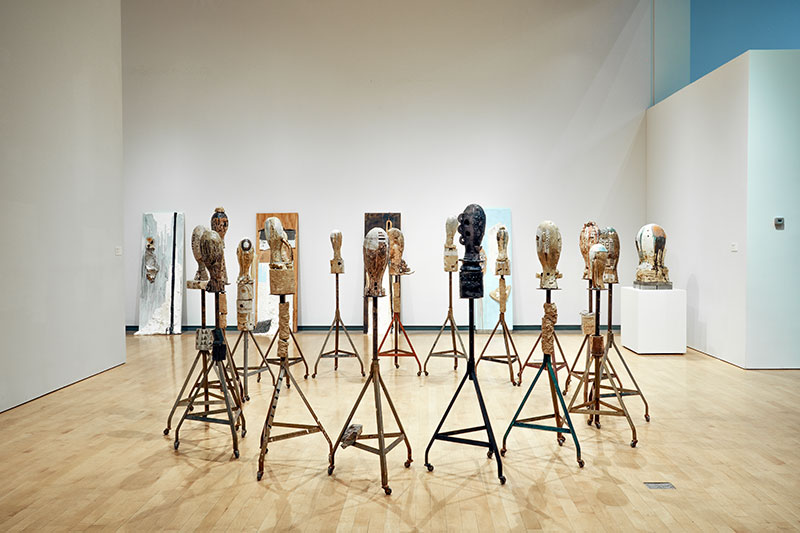
Patricia Sannit, Rise Fall Rise, 2017. Ceramic, glaze, found materials, concrete, rebar, wax, paint, mixed media. Installation view, Phoenix Art Museum. Photo: Mary Knopp.
PhxArt: What are the media that you prefer to work in and what topics and styles do you focus on?
PS: I trained as a potter and ceramic artist. Clay has been the foundation of my work for a long time. It has suited me well, and the material itself speaks to the continuity and collective memory of our species and is incredibly adaptable. It is used in everything from toothpaste to rocket engineering, and as an art material. The possibilities of clay are infinite and constantly growing. However, it is not the material for every expression. As I become increasingly more interested in ephemeral works, I have now begun working with video, performance, mixed media, and landscape intervention.
PhxArt: What topics does your work focus on, and what styles have inspired you?
PS: For most of my art career, human history has profoundly influenced me. I know that as humans, we have always shared common experiences, impulses, and desires. We build and create, fail and prevail, and attempt to order our natural world. This cycle, and our resilience, offers me hope.
A seminal experience was working as an excavator at the Neolithic site ʿAin Ghazal on the outskirts of Amman, Jordan. Working there and traveling in the region impacted me in two specific ways. First, the visual and geometric forms of the Middle East opened my eyes to patterns, and I recognized the relationship to the textile patterns I was familiar with from childhood. I came to see geometric patterns as a common language, one that I wanted to use in my work. Secondly, the process of excavation and learning about early human history connected me to our common humanity. Across the world, we are humans, sharing similar values and dreams. These universals continue to be at the core of my work. I work with ideas and materials that allow me to explore the resonance and randomness of history, as well as physical forces like pressure, heat, and gravity. Human history, our resilience, our hubris, our immense energy, and our ability to adapt have been at the core of my work.
More recently, the scope of my work has expanded to encompass a broader perspective of humans living on our planet. Like many others, the experiences over the past two years have shaped me. I feel compelled to live a good life, and take risks, because we live in a time of uncertainty. The focus of my work has expanded, and I am constantly trying new media and addressing our place as part of the natural world.

Patricia Sannit, Huldar: gras, 2021. Still from performance, Skagafjörður, Iceland. Painted canvas, grass, wind. Photo: Patricia Sannit.
PhxArt: Who are your greatest artistic influences?
PS: Oh, this is a long list. I am an avid consumer of contemporary art reviews and I read poetry, essays, and literature. Artists include the aforementioned John Chamberlain, Isamu Noguchi, Peter Voulkos, Viola Frey, Auguste Rodin, Eduardo Chillida, Marina Abramović, Ana Mendieta, Adrian Piper, and Bill Viola. Contemporary artists that influence me include Janine Antoni, Francis Alÿs, Joan Jonas, Pipilotti Rist, Kadar Attia, Linda Sormin, Sonya Clark, and Simone Leigh. As for the traditional arts, I am influenced by works from the Jōmon period of Japan; the art of East, Central, and West Africa; the Nazca Lines; Incan stonework; Outsider art; expressive functional pottery; carved wood; smooth stones; peeling paint; lichen; and others.
PhxArt: Tell us about your work as a teacher. What first inspired you to become an arts educator, and how does this work inform your personal practice?
PS: I am an information sponge and a curious person. I am very enthusiastic about art, culture, ceramics, and sharing my enthusiasm. I like getting people excited about ideas and art that I love and learning from my students. I love the problem-solving involved with teaching art and the endless iterative creativity demonstrated by artists. Every semester, I choose a different area of my field as a focus. Creating the assignments and lectures focusing on the chosen topic is endlessly stimulating.
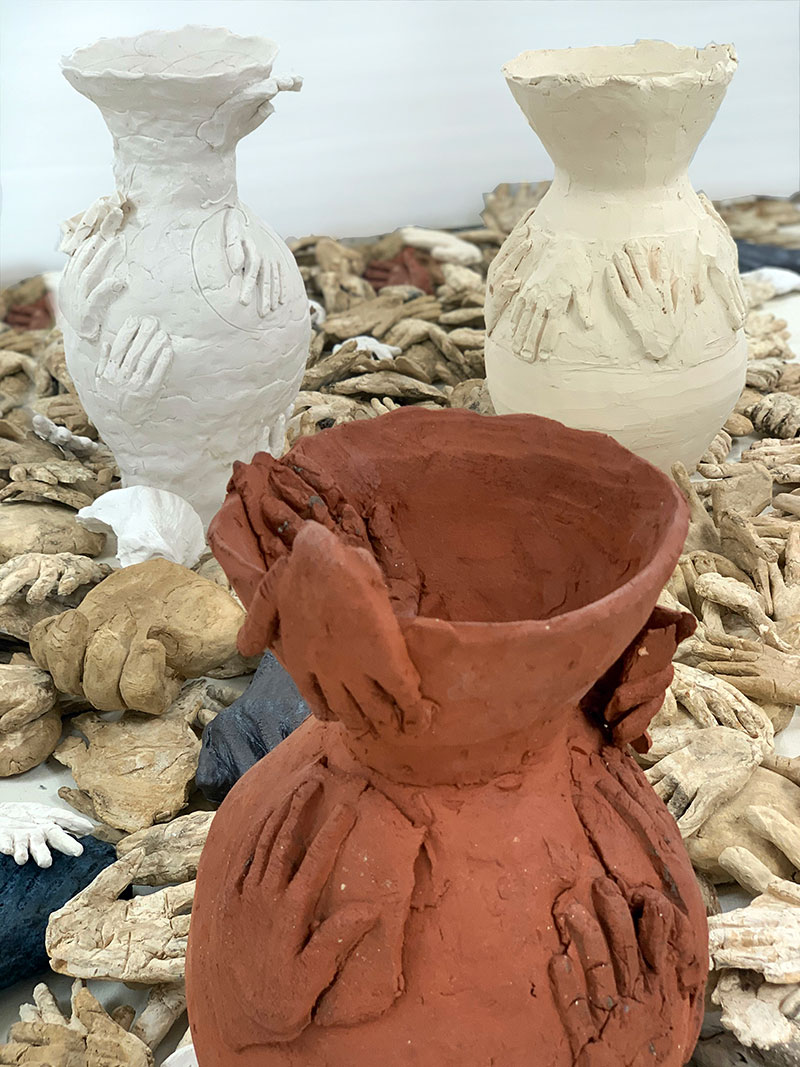
Patricia Sannit, Many Hands (hold me), 2021. Participatory project, volunteers made hundreds of clay hands while speaking about their experiences of isolation during the pandemic. Fired clay, wood, saw horse. Photo: Patricia Sannit.
PhxArt: What’s something you’re currently working on or have recently exhibited?
PS: I am not currently exhibiting my work, but in the past I presented my project that was developed during the pandemic, Many Hands (hold me), at the Scottsdale Center for Performing Arts as part of the exhibition Socially Distanced. Socially Distanced highlighted work created by 17 artists during the pandemic. These works correlated with the findings made by the Cooperation in the Apocalypse research team at Arizona State University, which describes social behaviors during isolation. I completed my residency at the Tempe Center of the Arts in association with the exhibition COLOR: the beauty and science of color and completed an artist residency in Hofsós, Iceland, where I experimented with video and performance in the landscape. In October, I will be in a residency in Sweden.
PhxArt: What is some advice you’d give to aspiring artists just beginning to build their professional practice?
PS: The advice I would give is: find a mentor, be a good person, work very hard, love what you do, follow your instincts, learn your history, be original, and don’t be afraid to take chances. And just work. It starts with the work; the art will follow.
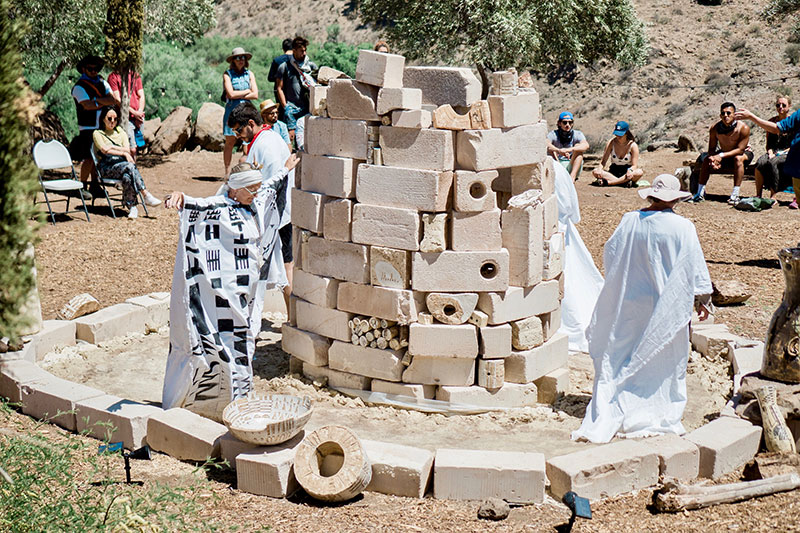
Patricia Sannit, Installation at FORM Arcosanti, presented by Phoenix Art Museum. Durational performance and participatory installation. Wet clay, sand, fired clay, furnace brick, video projection, fabric, performance. Performers include Nicole Olson, Patricia Sannit and volunteers. Photo: Airi Katsuta.
PhxArt: What can our community expect to see next from you?
PS: As part of my residency at the Tempe Center of the Arts in association with the exhibition COLOR: the beauty and science of color, I created a piece that dwells on the shifting colors of the human-made Tempe Town Lake in relationship to the natural landscape and the shifting pathways and history of the Salt River. In other big news, I am a partner in a new artist space, the Rocking S Art Ranch, in Central Phoenix. There are studios for 20+ artists! The rents are fair, and we have a good mix of artists working across media and activate the space with film, video, dance, and art events.
SEE MORE
To see more artwork by Patricia Sannit, visit www.patriciasannit.com or follow her on Instagram @patriciasannitstudio.
#CreativeQuarantine
PhxArt: We’re curious how creatives are navigating the time of coronavirus. Sabree Garcia shares what gave her life during the pandemic.
PS: COVID has taken a toll on all of us. In the beginning of the pandemic, I started Roadside Attraction, an outdoor, safe, citywide art exhibition with two other artists, Chris Jagmin and Lisa Olson. Over the course of three different iterations, in partnership with Scottsdale Museum of Contemporary Art and the City of Tempe, we provided a platform for more than 100 artists to present their work to the public in a safe way. My aforementioned project, Many Hands (hold me), was also a significant part of my pandemic experience. I set up an outdoor studio, and through social media and Artlink, I invited anyone interested to come to my studio and make hands. Dozens of people came over, made hands, and told their stories. Strangers became friends, and connections were made during a time of isolation. Making connections and community service kept me sane.
I also cooked a lot, hiked and biked for miles and miles, taught my daughter how to sew, helped my husband through his chemo treatments, made my 99-year-old father his evening martinis, and attended online concerts, lectures, and workshops. I also worked in my studio. As an artist, I realized that the only thing limiting me were my own expectations and if I wanted to try something new, now was the time. My brilliant and beloved husband has since passed and my father has turned 100. My dad is doing well, and he still has his nightly martini.
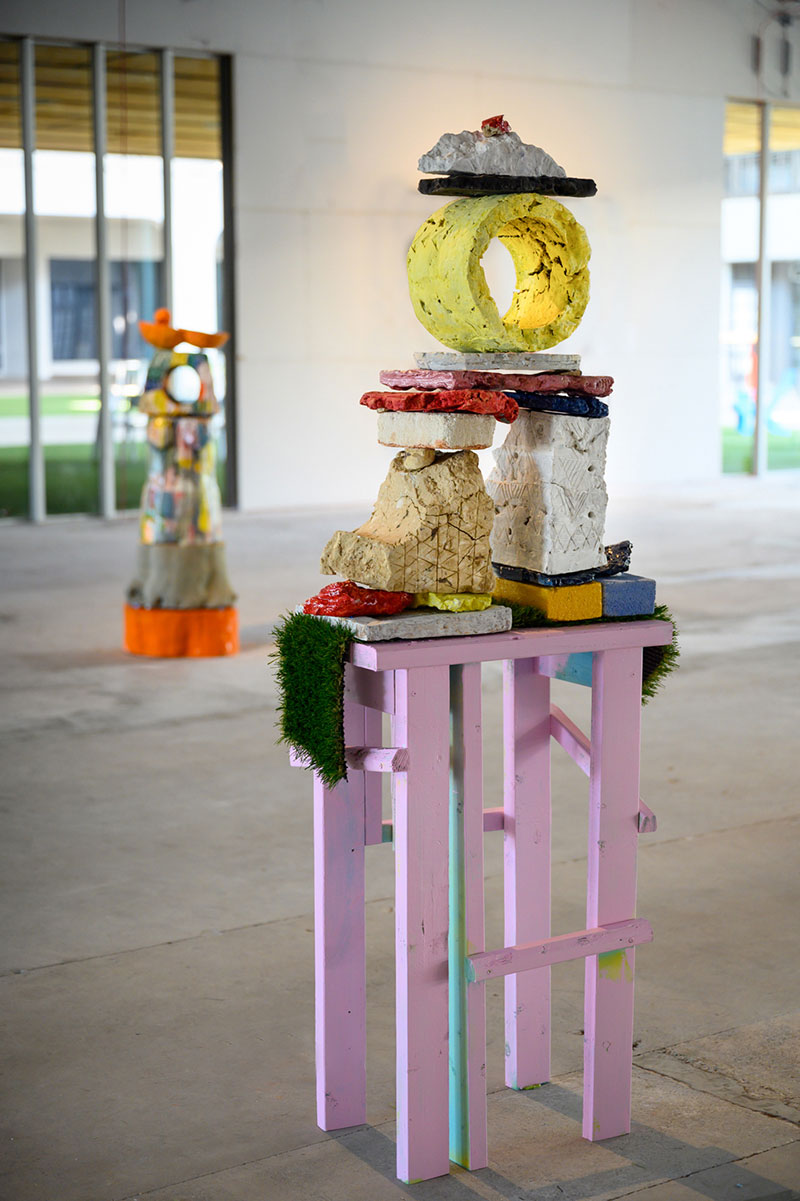
Patricia Sannit, Caryatid: Showing the Way, 2020. Fired clay, glaze, mineral oxides, artificial grass, lumber, paint. Photo: Mary Knopp.
Categories
What can we help you find?
Need further assistance?
Please call Visitor Services at 602.257.1880 or email